Graphs --- ADT and Traversing
Steven J. Zeil
Your text presents a variety of graph applications and algorithms, but does not present a general-purpose graph ADT. Instead, it works directly with adjacency matrices or adjacency lists.
In fact, most graphs algorithms tend to arise embedded within other data abstractions, so working directly with the data structures used to implement those application-specific ADTs may make sense.
I think, however, that the various graph algorithms are a lot easier to write and understand if we start with a graph ADT that supports the basic style of programming that we use with the C++ std library. So I present one here, not so much for practical use as to make the remaining algorithms more readable.
1 A Graph ADT
The std library does not contain a graph ADT as such,
although we have suggested ways that the std containers can be used to implement graphs in the last lesson. Such ad-hoc, tailored-to-a single-problem approaches do not lend themselves to the writing of reusable code, however, so it would be nice if a standard graph ADT were actually available.
The Boost library collection is a respected source of C++ libraries. In fact, it has served as a proving ground for a lot of ADTs that eventually made their way into std as the C++ language advanced to C++11, C++14, C++17, and C++20.
We are going to use the Boost Graph library because
- It’s seen a fair amount of peer review and practical use.
- It might someday become part of C++.
- And even if it doesn’t, it’s very consistent with the style of the
stdlibrary components. - It allows us to write many common graph algorithms in ways that are portable over different data structures.
The Boost Graph library supports both of the main data structures we have considered: the adjacency matrix and adjacency lists.
But it hides that choice behind class interfaces that offer a common view of such graph concepts as vertices and edges. Because many practical uses of graphs involve storing data of some kind in each vertex, on each edge, or both, the Boost Graph library provides mechanisms for maps keyed by either vertices or by edges.
Instructions on installing the Boost library can be found on the Library page. A summary of the graph functions is here.
1.1 The Graph
The actual graph types are named for their underlying implementation. For example, a digraph implemented using adjacency lists is
#include <boost/graph/adjacency_list.hpp>
⋮
using namespace boost;
⋮
typedef adjacency_list<listS, vecS, bidirectionalS> Graph;
Graph g;
The template parameters to adjacency lists are
-
The data structure used to store edges for each vertex.
listSindicates that a standard list will be used. As you might suspect, this allows for easy and fast addition and removal of edges. -
The data structure used to denote the vertices.
vecSindicates that a vector will be used.This is a convenience for people just starting with the Boost Graphs library, because it means that vertices can be identified with integer values (in the order that they are added to the graph).
It will also simplify the creation of map-like structures to associate data with each vertex, something we will do in many algorithms.
-
bidirectionalSis a tag indicating that this will be a digraph, but that we we will be able to iterate over incoming edges to a vertex as well as iterate over outgoing edges.If we don’t need easy access to incoming edges, then
directionalSsaves time and memory by omitting the extra storage of incoming edges.If we want an undirected graph instead of a digraph, use
undirectedS.
1.2 Vertices
typedef boost::graph_traits<Graph> GraphTraits;
typedef GraphTraits::vertex_descriptor Vertex;
You can add vertices to a graph with add_vertex
Vertex v = add_vertex(g);
You can also create a graph holding a fixed number of vertices:
Graph g(6); // create a graph with 6 vertices
You can iterate over all of the vertices in a graph by using vertices(g) to get a pair of iterators denoting a starting and stopping position:
auto vertexRange = vertices(g);
for (auto v = vertexRange.first; v != vertexRange.second; ++v)
doSomethingWithVertex(*v);
You can find out how many vertices are in a graph with num_vertices(g):
unsigned nV = num_vertices(g);
1.3 Edges
After vertices, the next obvious step is to look at edges.
typedef GraphTraits::edge_descriptor Edge;
Adding edges to a graph is easy:
Edge e = add_edge (v1, v2, g).first;
The add_edge function actually returns a pair, the first component being the edge, the second being a boolean indicating whether this was a new edge or not (i.e., it was already in the graph).
You can recover the source and destination vertices of an edge
Vertex src = source(e, g);
Vertex dest = target(*e, g);
And, after having added several edges, you can iterate over all of the edges in the graph:
auto edgeRange = edges(g);
for (auto e = edgeRange.first; e != edgeRange.second; ++e)
{
doSomethingWith(*e);
}
You can find out how many edges are in a graph with num_edges(g):
unsigned nE = num_edges(g);
1.4 Adjacency
Once you have added a number of vertices and edges to a graph, you can explore the adjacency relationships by requesting ranges of iterators for vertices/edges related to a given vertex.
For example, given a vertex v0, you can explore all vertices adjacent to it:
auto vertexRange = adjacent_vertices(v0, g);
for (auto w = vertexRange.first; w != vertexRange.second; ++w)
doSomethingWithVertex(*w);
The number of edges emerging from a vertex is called the out-degree of that vertex, and can be found like this:
unsigned numOut = out_degree(v0, g);
You can access those outgoing edges by requesting a pair of iterators:
auto edgeRange = out_edges(v0, g);
for (auto e = edgeRange.first; e != edgeRange.second; ++e)
doSomethingWithEdge(*e);
When you declare a graph type, you have the option of having it track incoming edges to each vertex as well as outgoing edges. Boost calls these bidirectional graphs (not to be confused with undirected graphs, in which each edge can be traversed in either direction).
The number of edges pointing to a vertex is called the in-degree of that vertex, and, for bidirectional graphs, can be found like this:
unsigned numOut = in_degree(v0, g);
You can access those incoming edges, for bidirectional graphs, by requesting a pair of iterators:
auto edgeRange = in_edges(v0, g);
for (auto e = edgeRange.first; e != edgeRange.second; ++e)
doSomethingWithEdge(*e);
You can see that the Boost graph types are largely concerned with providing pairs of iterators for different purposes.
You can check to see if a specific edge exists between two vertices v and w in the graph g with the edge function:
auto checkEdge = edge(v, w, g);
if (checkEdge.second)
{
// the edge exists
Edge e = checkEdge.first;
⋮
}
Keep in mind that the complexity of this check depends on the underlying data structure used for the graph. For adjaceny lists (which we have been using throughout this lesson), the edge function is $O(\mbox{out}_v)$, where $\mbox{out}_v$ is the out-degree of v.
1.5 Attaching Data to Vertices and Edges
To actually use graphs in practical problems, we usually wind up associating data values of some kind to either the vertices, the edges, or both.
We can draw a distinction here between permanent data that becomes part of the graph for as long as that graph exists, and temporary data that is set up by some algorithm and that disappears when that algorithm is completed.
1.5.1 Permanent data
The Boost Graph Library supports permanent data by a process that it calls “bundling”. Two parameters in the declaration of adjacency_list allow us to attach data types to vertices and edges.
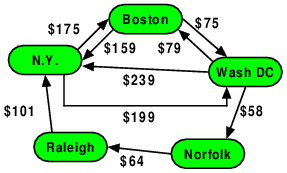
For example, suppose that we wanted to construct this graph denoting an airline’s pricing for flying from one city to another.
We can do this by creating new classes or structs holding the data we want.
struct Flight { // data for edges
int price; // in dollars
};
struct Airport { // data for vertices
string city;
};
Then we add those classes to the declaration of our graph type
typedef boost::adjacency_list<boost::listS, // store edges in lists
boost::vecS, // store vertices in a vector
boost::bidirectionalS, // a directed graph
Airport, // vertex data
Flight // edge data
>
AirlineGraph;
AirlineGraph ag(5);
Now, whenever we have a vertex, v, we can access its data like this:
cout << "We are in " << ag[v].city << endl;
and whenever we have an edge, e, we can access its data similarly:
ag[e].price = ag[e].price + 50; // price hike
To fill out the example, here is rest of the code to build that graph:
enum Cities {Boston, NY, WashDC, Norfolk, Raleigh, endofCities};
std::array<string,5> cityNames {"Boston", "NY", "WashDC",
"Norfolk", "Raleigh"};
typedef pair<Cities, Cities> cpair;
pair<Cities, Cities> flights[] {
cpair(NY, Boston), cpair(NY, WashDC),
cpair(Boston, NY), cpair(Boston, WashDC),
cpair(WashDC, Boston), cpair(WashDC, NY), cpair(WashDC, Norfolk),
cpair(Norfolk, Raleigh),
cpair(Raleigh, NY)
};
int prices[] {
175, 199,
159, 75,
79, 239, 58,
64,
101,
-1 // stop value
};
AirlineGraph ag(5);
for (Cities i = Boston; i != endofCities; i = Cities(i+1))
{
ag[(Vertex)i].city = cityNames[i];
}
for (int i = 0; prices[i] >= 0; ++i)
{
auto e = add_edge ((Vertex)flights[i].first,
(Vertex)flights[i].second,
ag).first;
ag[e].price = prices[i];
}
1.5.2 Temporary Data
If we want to associate data temporarily with either vertices or edges, we need to set up something like a map that would let us retrieve and store data values by vertex or edge.
The usual method for doing this would be to use an unordered_map. The Boost library provides hash functions for both vertices and edges, so we can define maps with those as keys, e.g.:
std::unordered_map<Vertex, bool, boost::hash<Vertex> > processed;
std::unordered_map<Edge, double, boost::hash<Edge> > distances;
Another option is open because we have chosen, in these examples, to have the Boost graph store the vertices in a vector. Our Vertex type is actually an integer, and we can use that with ordinary arrays or vectors.
For example, suppose that we wanted to temporarily label each vertex in a graph g with a boolean indicating whether it had been processed or not, initially set to false.
auto allVertices = vertices(g); // a pair of iterators
int nVertices = num_vertices(g);
vector<bool> processed (nVertices, false);
⋮
if (!processed[v])
{
doSomethingToVertex(v);
processed[v] = true;
}
⋮
2 Traversing a Graph
Many problems require us to visit all the vertices of a graph.
- For that we can use the
vertices(g)iterators.
Very often, however, we want to visit all of the vertices that can be reached from some starting vertex.
- We can adapt some of the traversal techniques that we learned for trees.
- This will yield the “depth-first” and “breadth-first” traversals for graphs.
In fact, the easiest way to get started on these kinds of traversals is to recognize the special relation between connected graphs and trees.
Every tree is a graph (i.e., it is a set of vertices and a set of edges connecting those vertices), but not every graph is a tree. A tree is a connected graph in which each vertex is adjacent to at most one other vertex (its parent).
Not every graph is a tree, but we can sometimes find useful trees embedded within graphs.
2.1 Spanning Trees
A spanning tree for a connected graph $G=(V,E)$ is a graph $G’=(V,E’)$ such that $E’ \subseteq E$ and $G’$ is a tree. The spanning tree is a tree that is “embedded” in the graph.
- They are useful when we need to do something with each vertex, but using as few edges as possible.
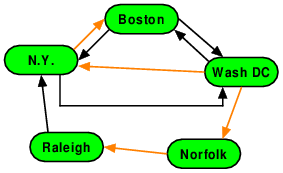
Question:
Is the set of vertices and orange edges shown here a spanning tree for the entire graph? If so, what is its root?
-
No.
-
Yes. The root is Boston
-
Yes. The root is N.Y.
-
Yes. The root is Norfolk
-
Yes. The root is Raleigh
-
Yes. The root is Wash DC
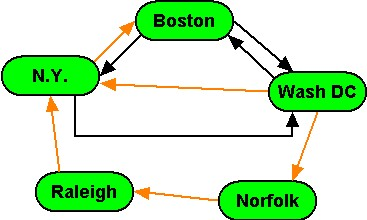
Question:
Is the set of vertices and orange edges shown here a spanning tree for the entire graph? If so, what is its root?
-
No.
-
Yes. The root is Boston
-
Yes. The root is N.Y.
-
Yes. The root is Norfolk
-
Yes. The root is Raleigh
-
Yes. The root is Wash DC
For undirected graphs, any acyclic, connected subset of E is a tree.
Note that, while an undirected graph always contains the edge $(v,w)$ iff it also contains $(w,v)$, the spanning tree of an undirected graph cannot contain both $(v,w)$ and $(w,v)$, as those two edges alone would constitute a cycle.
2.2 Depth-First Traversals - Trees
Consider the problem of searching a general tree for a given node.
-
In a depth-first traversal, we investigate one child’s descendants before exploring its right siblings.
-
In a breadth-first traversal, we explore all nodes at the same depth before moving on to any deeper nodes.
Most of the tree traversals that we looked at (prefix, postfix, and infix) were all variations of the depth-first idea.
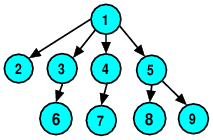
Question: In what order would a depth-first tree traversal, starting from node 1, visit these nodes? (Assume that children of the same node are processed in increasing numeric order.)
-
1 2 3 4 5 6 7 8 9
-
1 2 3 6 4 7 5 8 9
-
2 3 6 1 4 7 8 5 9
-
None of the above.
The prototypical code for depth first tree traversal is
void depthFirst (TreeNode* t)
{
if (t != 0)
for (int i = 0; i < t->numChildren; ++i)
depthFirst (t->child[i]);
}
We convert this into a preorder or postorder process depending upon whether we process a node before or after visiting its children.
2.3 Depth-First Traversals of Graphs
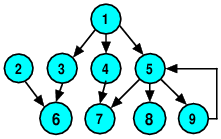
Now, if we apply this same idea to a graph instead of a tree, starting with vertex 1:
void depthFirst (Graph& dg, Vertex v)
{
auto edgeRange = out_edges(v, dg);
for (auto e = edgeRange.first;
e != edgeRange.second; ++e)
{
Vertex w = target(*e, dg);
depthFirst (dg, w);
}
}
we can see some problems:
-
We never reach vertex 2, because there is no path to it from vertex 1.
-
That’s probably OK. We are presumably only interested in the vertices that are reachable from vertex 1, otherwise we wouldn’t be doing a depth-first traversal in the first place. Instead we would use the
vertices(g)iterators.
-
-
Vertex 7 will be visited once as a “child” of 4, and visited again when we reach vertex 5.
-
Worst of all, we will eventually go from 5 to 9, from 9 back to 5, then to 9 again, and so on, recursing forever (or until we run out of memory for the activation stack).
2.3.1 Using Sets to Cope with Cycles
We can adapt the tree algorithm for use in graphs by using some sort of data structure to keep track of which nodes have already been visited:
void depthFirst (Graph& dg, Vertex v, set<Vertex>& visited)
{
visited.insert (v);
auto edgeRange = out_edges(v, g);
for (auto e = edgeRange.first;
e != edgeRange.second; ++e)
{
Vertex w = target(*e, dg);
if (visited.count(w) == 0)
depthFirst (dg, w, visited);
}
}
The visited set records the vertices that we have already seen. When we are examining adjacent vertices to recursively visit, we simply pass over any that we have already visited.
The use of the set will slow this traversal a little bit, though we know that the std::set operations used here are only O(log |V|). We could get even faster average time by using hashing (unordered_set).
Try out the depth-first search in an animation.
- Note that searching for a node that can’t be reached from the starting point is equivalent to doing a complete depth-first traversal.
Question:
What can you say about this set of edges at the end of a full traversal?
-
They are cyclic.
-
They form a spanning tree of the entire graph.
-
They form a spanning tree of the portion of the graph reachable from the start
-
They are not connected.
In fact, the set of edges that could be collected during a depth-first traversal is called a depth-first spanning tree.
We can actually speed this up by taking advantage of the fact that we have chosen to store our Boost graph vertices in a vector, so that Vector is actually an integer type:
template <typename Action>
void depthFirst (Graph& dg, Vertex v, Action doSomethingTo)
{
auto allVertices = vertices(dg);
unsigned n = distance(allVertices.first, allVertices.second);
bool* visited = new bool[n];
fill_n (visited, n, false);
depthFirst (dg, v, visited, doSomethingTo);
delete [] visited;
}
template <typename Action>
void depthFirst (Graph& dg, Vertex v, bool* visited, Action doSomethingTo)
{
visited[v] = true;
doSomethingTo(v);
for (auto e = edgeRange.first;
e != edgeRange.second; ++e)
{
Vertex w = target(*e, dg);
if (!visited[w])
depthFirst (dg, w, visited);
}
}
The first function sets up an array to serve a temporary “map” from vertices to booleans, initializing all entries to false. It then launches the recursive version of the traversal, which uses quick $O(1)$ array operations to track which vertices have already been visited. Upon return from the recursive traversal, the first function then cleans up the temporary storage.
2.4 Breadth-First Traversal of Trees
Breadth-first visits each node at the same depth (distance from the starting node) before moving on to more distant nodes.
In trees, this is also called “Level-Order” traversal.

Question: In what order would a breadth-first tree traversal, starting from node 1, visit these nodes?
-
1 2 3 4 5 6 7 8 9
-
1 2 3 6 4 7 5 8 9
-
2 3 6 1 4 7 8 5 9
-
None of the above.
The prototypical code for breadth first tree traversal is
void breadthFirst (TreeNode* root)
{
queue<TreeNode*, list<TreeNode*> > q;
q.push (root);
while (!q.empty())
{
v = q.front ();
q.pop ();
for (int i = 0; i < v->numChildren(); ++i)
{
TreeNode* w = v->child[i];
if (w != 0)
q.push (w);
}
}
}
We use a queue to receive the list of vertices to be visited, starting with the root, then the root’s children, then the root’s grandchildren, and so on.
2.5 Breadth-First Traversal of Graphs

Again, that tree code would have problems (including going into an infinite loop) if applied to more general graphs.
But we can use the same idea of a set of already-visited vertices to adapt this idea to traversing graphs.
Try out the breadth-first search in an animation.
Note that this also visits a spanning tree of the portion of the graph reachable from the start. This shorter, broader tree is called a breadth-first spanning tree.
To implement our Boost-based traversal, we will again choose to use an array to track which vertices have been visited.
template <typename Action>
void breadthFirstTraversal (const Graph& g,
const Vertex& start,
Action doSomethingWith)
{
using namespace std;
queue<Vertex, list<Vertex> > q;
auto allVertices = vertices(g); ➀
unsigned n = num_vertices(g);
bool* visited = new bool[n];
fill_n (visited, n, false);
q.push (start); ➁
visited[start] = true;
while (!q.empty())
{
Vertex v = q.front(); ➂
q.pop();
doSomethingWith(v);
auto outgoing = out_edges(v,g); ➃
for (auto e = outgoing.first; e != outgoing.second; ++e)
{
Vertex w = target(*e, g);
if (!visited[w])
{
q.push (w);
visited[w] = true;
}
}
}
delete [] visited; ➄
}
- ➀: Set up the temporary mapping from vertices to booleans.
- ➁: Initialize the queue so that our starting vertex will be processed on the first pass through the loop.
- ➂: Each time around the loop, pop a vertex and process it.
- ➃: Then add its unprocessed neighbors to the queue.
- ➄: Final cleanup.
Almost every graph algorithm is based upon either depth-first or breadth-first search.
-
Depth-first may be slightly easier to program, as it does not require an additional ADT (the queue).
Although, interestingly enough, if we replace the queue in the above code by a stack, we get a non-recursive depth-first traversal algorithm!
-
Breadth-first (or depth-first using an explicit stack) is slightly faster.
The appropriate choice often depends upon the nature of the search and what you are trying to accomplish with your particular algorithm.


